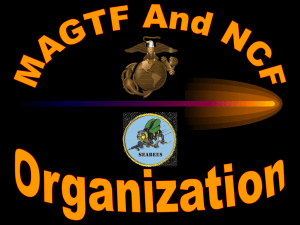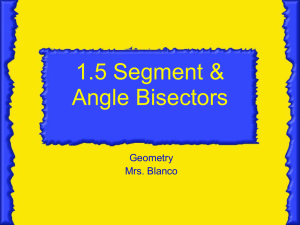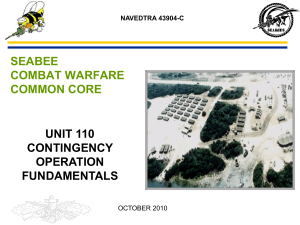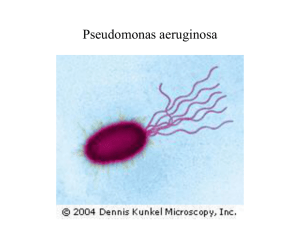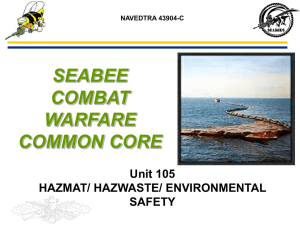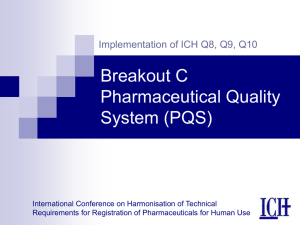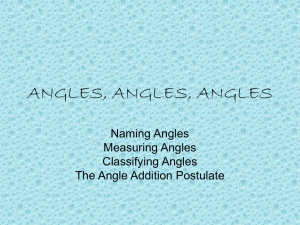DOCTRINE FUNDAMENTALS
advertisement
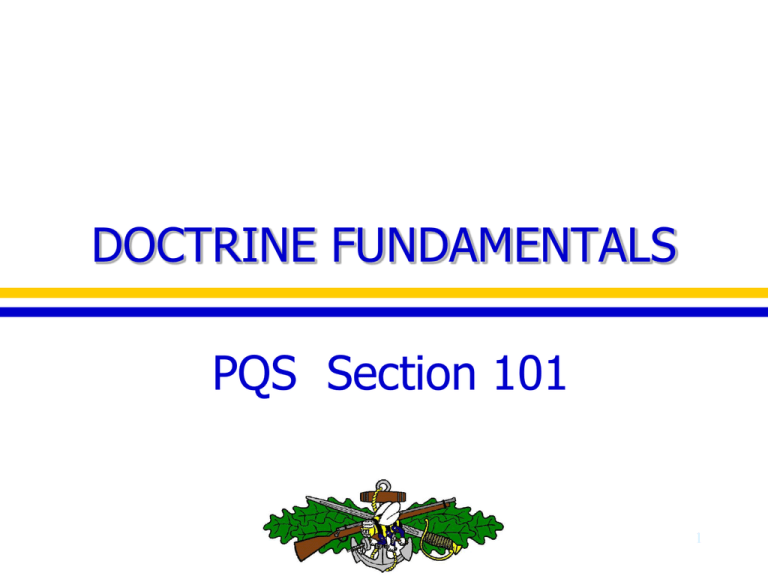
DOCTRINE FUNDAMENTALS PQS Section 101 1 101.1 Discuss the different capabilities of Air Force, Army, and Marine Corps engineering units. Army – Provides military troop construction support to the Air Force overseas Marine Corp – General engineering support to MAGTFs Air Force – Provides military troop engineer support to other services NMCB Officer PQS Page 2 101.2 Discuss the Naval Construction Force (NCF) Officer’s Role in support of a Joint Task Force (JTF) Provide direct engineering support to the MAGTF Capabilities may be extended to – MOOTW (military operation other than war) – Humanitarian aid – Disaster relief operations NMCB Officer PQS Page 3 101.3 Discuss the purpose of the following in relation to NCF Doctrine a.) Naval Construction Force Support of Marine Air-Ground Task Force Operations (NWP4-04.1) NMCB Officer PQS Enhance understanding between MAGTF and NCF Commanders Describe NCF missions, organizations and capabilities Allow effective integration, coordination and employment of Seabees in to the MAGTF providing considerable combat service support force multiplier for the MAGTF Commander Page 4 101.3 Discuss the purpose of the following in relation to NCF Doctrine (cont.) b.) Naval Civil Engineer Corps Operations NWP 4-04.2 NMCB Officer PQS A doctrinal basis of Tactics, Techniques and Procedures for Navy Civil Engineer operations in support of JTF The mission, task, organization, and capabilities are describe to allow Navy Civil Engineer capabilities in to JTF operations Page 5 101.3 Discuss the purpose of the following in relation to NCF Doctrine (cont.) c.) Unified Action Armed Forces (UNAAF-Jointpub02) NMCB Officer PQS Sets doctrine, principles and policy to govern joint activities and performances of the Armed Forces of the United States Designates command relationships and authority military commanders can use Provides doctrine, principles,and policy for exercising authority, organizing joint forces Page 6 101.4 Define the following terms and discuss how they apply to NCF operations within the MAGTF a.) MEU - Marine Expeditionary Unit – Provides an immediate reaction capability to crisis. b.) MEF - Marine Expeditionary Force – Task organized and tailored for any intensity of combat to any geographic environment. c.) MEF-F - Marine Expeditionary Force (Forward) – Task organized and capable of conducting operations in low and mid-intensity conflict environments NMCB Officer PQS Page 7 101.4 Define the following terms and discuss how they apply to NCF operations within the MAGTF (cont.) d.) GCE - Ground Combat Element – Tailored to conduct ground maneuver operations – Constructed around a combat infantry unit e.) ACE - Aviation Combat Element – Tailored to conduct tactical air operations – Constructed of aviation commands and their support f.) CSSE - Combat Service Support Element – Provides combat service support beyond the organic capabilities of the other elements. (ADP, supply, medical) NMCB Officer PQS Page 8 101.4 Define the following terms and discuss how they apply to NCF operations within the MAGTF (cont.) g.) CE - Command/Combat Element – Headquarters. Established for effective planning and execution. A CEC officer is attached to the CE, engineer staff. h.) MSC - Military Sealift Command – Asset to MAGTF for transportation of equipment NMCB Officer PQS Page 9 101.4 Define the following terms and discuss how they apply to NCF operations within the MAGTF (cont.) GCE ACE MEU Battalion Landing Team (BLT) Helicopter Squadron MEF-F Regimental Landing Team (RLT) Marine Aviation Group (MAG) Brigade Service Support Group (BSSG) NMCB Marine Division Marine Air Wing (MAW) Force Service Support Group (FSSG) NCR MEF NMCB Officer PQS CSSE Marine Service Support Group (MSSG) NCF AirDet/Dets Page 10 Administration/Command & Control Fundamental Officer PQS 102 11 102.1 Discuss the main elements contained in a Judge Advocate General (JAG) investigation and when to conduct an investigation There are three types of investigations. – Command Investigations – Litigation-Report Investigations – Courts and Boards of Inquiry NMCB Officer PQS Page 12 102.1 Discuss the main elements contained in a Judge Advocate General (JAG) investigation and when to conduct an investigation (cont.) Command Investigation – To gather, analyze, and record relevant information about an incident or event of primary interest of command authorities Conducted for the following reasons: – significant property losses. – possible misconduct, disease or injury leading to permanent disability or inability to perform duty exceeding 24 hours. – death of military or civilian personnel caused by suicide or unusual circumstance. – aircraft incidents, grounding, flooding, fires and collisions which are not major incidents. NMCB Officer PQS Page 13 102.1 Discuss the main elements contained in a Judge Advocate General (JAG) investigation and when to conduct an investigation (cont.) Litigation-Report Investigation – Prepare to defend the legal interest of the Department and the United States against claims or civil litigation Conducted for the following reasons: – – – – NMCB Officer PQS conducted under direction of a judge advocate. conducted primarily for claims or litigation. same reasons as that of a command investigation. incidents which cause significant damage to the environment. Page 14 102.1 Discuss the main elements contained in a Judge Advocate General (JAG) investigation and when to conduct an investigation (cont.) Courts and Boards of Inquiry – Use a hearing procedure and should be reserved for the investigation of major incidents, serious, significant events. NMCB Officer PQS Page 15 Main Elements of Investigation Responsible – – – – for initiating generally an officer in charge. an another command upon request. the nearest command. incidents involving Marine Corps personnel. Convening Order – official letter from the convening authority to the investigation. – recites the specific purposes of the inquiry. – Contains explicit instruction about scope. NMCB Officer PQS Page 16 Elements (cont.) Method – convened in writing and collects evidence. – May contain sworn statement. – One or more investigators. Time limitations – due normally in 30 days of convening order – completed in 20 days for deaths. Evidence and Witnesses NMCB Officer PQS Page 17 102.2 Discuss the Status of Resources and Training System (SORTS) and the different levels of readiness. Principal report to provide status data to the National Command Authority. Not used as a performance appraisal of a Command Officer. Overall picture of Units combat readiness at the time of report. There are two section, Part I and Part II. Individual reports classified CONFIDENTIAL. Trends classified SECRET. NMCB Officer PQS Page 18 102.2 Discuss the Status of Resources and Training System (SORTS) and the different levels of readiness. (cont.) Reporting – – – – – – – requirements Upon departure of AP and arrival of MB. Departure of Air Det, but not for exercises. In response to a Navy sorts Quarterly Evaluation. Within 4 hr of a change in C/M status Change in unit structure strength of plus or minus 5 %. Change of command. Upon request from higher authority. NMCB Officer PQS Page 19 102.2 Discuss the Status of Resources and Training System (SORTS) and the different levels of readiness. (cont.) Categories and Mission Areas – 4 primary mission areas (PRMAR): M ratings CCC- command, control and communication CON- construction MOB- mobility FSO-fleet support operations – 4 categories: C ratings PER-personnel SUP- supply EQP-equipment TNG-training NMCB Officer PQS Page 20 102.2 Discuss the Status of Resources and Training System (SORTS) and the different levels of readiness. (cont.) Level of Readiness – M/C1- capable of performing FULL wartime mission. – M/C2- capable of performing BULK of wartime mission. – M/C3- capable of performing MAJOR portions of wartime mission. – M/C4- requires additional resources and /or training in order to undertake wartime mission. – M/C5- undergoing a service-directed resource change and not prepared for wartime mission. NMCB Officer PQS Page 21 102.3 Define the following terms and discuss the differences between them. Gaining a.) OPCON NMCB Officer PQS commander receives complete authoritative direction over assigned units for operational matters and has responsibility for all matters except logistics, admin, discipline, internal organization, and unit training. Page 22 102.3 Define the following terms and discuss the differences between them. (cont.) Gaining b.) ADCON NMCB Officer PQS commander receives authoritative direction in respect to administrative matters such as personnel management, supply, services, and other matters not included in the operational mission. Page 23 102.3 Define the following terms and discuss the differences between them. (cont.) Gaining c.) TACON NMCB Officer PQS commander receives temporary tactical authority over the unit assigned to him or located in his area. He may tactically direct the unit or plan its employment while assigned or located in his area to complete assigned mission or tasking. Page 24 102.4 Discuss the differences between a unit providing general support to another unit and one providing direct support to another unit. Direct support (DS) is were a parent command provides support to another unit, were as general support (GS) provides support to their own parent commander’s force as a whole. For DS, communications are established between units but not necessary with GS units. For DS, the supported unit is relieved of the admin and logistic burdens not the case for GS. For DS, the parent command must provide consistent support by established plans, in a GS, the commander retains control of organic assets and attached elements and uses them to benefit the parent command as a whole. NMCB Officer PQS Page 25 SUPPLY/LOGISTICS FUNDAMENTALS PQS Section 103 26 103.1 Discuss the Pre-positioned War Reserve Management System (PWRMS) and how it is utilized within the Naval Construction Force (NCF). Active NMCB units have a complete TOA assigned to the custody of the NCBs and their Fleet CINCs. The TOA for reserve NCF units and CBUs is managed under the PWRMS program. The PWRMS program is managed and controlled by Seabee Logistics Center (SLC) for the the program sponsor CNO (N41). NMCB Officer PQS Page 27 103.1 Discuss the Pre-positioned War Reserve Management System (PWRMS) and how it is utilized within the Naval Construction Force (NCF). SLC’s Responsibilities – Develops/maintains TOA standards – Ensures equipment in TOA air-certifiable – Procures, stores, maintains PWRMS for NCF reserve units – Provides/coordinates planning, programming, budgeting of all TOA and PWRMS Implements centralized CESE & PWRMS mgmt – Maximizes program cost effectiveness – Coordinates Advanced Base Functional Components (ABFC) and TOA for NCF units – Serves as Logistics Agent for NCF participation in MPF Program (***NCF MPF TOAs are PWRMS!) NMCB Officer PQS Page 28 103.2 Discuss the Maritime Pre-positioned Force (MFP) principles of strategy and their relationship in support of the Marine AirGround Task Force (MAGFT). Definition; A strategic deployment option that quickly combines substantial pre-positioned equipment/supplies loaded aboard ships of a Maritime Pre-positioning Ship Squadron (MPSRON) with a Marine Air-Ground Task Force (MAGTF) to establish a mechanized force. MAGTF, Naval Construction Regiment (NCR), Naval Support Element (NSE) personnel, selected equipment, combat aircraft flown into arrival and assembly area (AAA) where Maritime Pre-positioning Force (MPF) operation occurs NMCB Officer PQS Page 29 103.2 Discuss the Maritime Pre-positioned Force (MFP) principles of strategy and their relationship in support of the Marine AirGround Task Force (MAGFT). (cont.) Capabilities/Functions of MPF – – – – Reinforce amphibious operation Occupy/reinforce advanced naval base Reinforce ally with credible force prior to hostilities Establish sizable force ashore in support of ops ashore – Augment fleet defense by providing tactical air support from ashore – Provide rapid peacetime response for Military Operations other Than War (i.e. disaster relief) NMCB Officer PQS Page 30 103.2 Discuss the Maritime Pre-positioned Force (MPF) principles of strategy and their relationship in support of the Marine AirGround Task Force (MAGTF) (cont.) Calls for MPSRON forward deployed with combat equipment and sustaining supplies for MAGTF of 17,000 personnel for 30 days – (1) MPF Operation is ordered – (2) Marines, Sailors, Seabees of MAGTF, NSE, NSR airlifted by Air Mobility Command (AMC) to AAA – (3) Equipment/supplies off-loaded and issued to combat units NMCB Officer PQS Page 31 103.2 Discuss the Maritime Pre-positioned Force (MPF) principles of strategy and their relationship in support of the Marine AirGround Task Force (MAGTF) (cont.) – (4) MAGTF Commander states he is combat ready – (5) MPF terminated – (6) Operational control of MAGTF transferred to numbered fleet commander, joint/combined task force commander, or geographic commander, Marine Forces for subsequent operations ashore NMCB Officer PQS Page 32 103.2 Discuss the Maritime Pre-positioned Force (MFP) principles of strategy and their relationship in support of the Marine AirGround Task Force (MAGFT). (cont.) Phases of MPF Operations – (1) Planning – (2) Marshalling – (3) Movement – (4) Arrival and Assembly NMCB Officer PQS Page 33 103.2 Discuss the Maritime Pre-positioned Force (MFP) principles of strategy and their relationship in support of the Marine AirGround Task Force (MAGFT). (cont.) 5 Movement Groups for MPF Operations – (1) Survey, Liaison, Reconnaissance Party (SLRP): forms initial element of Advance Party, disestablished when AAA Operations Group (AAAOG) established, activated for operations – (2) Off-Load Preparation Party (OPP): maintenance/equipment operators from MAGTF elements and NSE who become nucleus of ship’s debarkation teams upon completion of off-load preparations NMCB Officer PQS Page 34 103.2 Discuss the Maritime Pre-positioned Force (MFP) principles of strategy and their relationship in support of the Marine AirGround Task Force (MAGFT). (cont.) – (3) Advance Party: formed from personnel from SLRP + equipment/individuals from deploying elements of MB; establishes AAAOG, Leading Force Support Party (LFSP), and AAAOG Elements – (4) Main Body: remaining forces not in AAA operations (i.e. combat forces) – (5) Flight Ferry: involves movement of self-deploying aircraft, including associated support personnel equipment and aerial refueling aircraft NMCB Officer PQS Page 35 103.3 List the different echelons of your unit’s Table of Allowance (TOA). In both contingency and day-to-day operations, NCF unit may be required to support, simultaneously, multiple projects, tasks, locations. Preplanning for such contingencies/management of resources required to support these operations are aided by “echeloning” certain TOAs. Echeloning is based on anticipated prioritization of personnel, material/equipment, availability of airlift vs. sealift support NMCB Officer PQS Page 36 103.3 List the different echelons of your unit’s Table of Allowance (TOA) (cont.) All echelons combined from NAVFAC P-25 (NMCB TOA) for 763 personnel Breakdown: – (1) Air Det - P25A 89 personnel (2 officers, 87 enlisted) 48-hr mount-out – (2) Air Echelon (AE) - P25C 649 personnel 6-day mount-out – (3) Sea Echelon (AS) - P25D 25 personnel 30-day arrival ship riders NMCB Officer PQS Page 37 103.3 List the different echelons of your unit’s Table of Allowance (TOA) (cont.) Current Transition to Modules TOA - P25M – (1) Fly in Mod – (2) Core Mod 782 Gear 250 man Camp Personal weapons 59 pieces CESE Some Comm Gear Tools for 250 Det MREs Basic support items NMCB Officer PQS Full support for Air Det size unit Page 38 103.3 List the different echelons of your unit’s Table of Allowance (TOA) (cont.) – (3) Basic Mod – (4) Heavy Mod B/C Co Shops A Co Shops 38 pieces of CESE A Co large tools Vertical const support 42 pieces of CESE ABM Horizontal const support Trenchers Water well/pile HQ Co items NMCB Officer PQS driving/Distributor Page 39 103.3 List the different echelons of your unit’s Table of Allowance (TOA) (cont.) MPF (Enhanced) Echelons CORE ECHELON BASIC ECHELON HEAVY ECHELON Core Module Core Module Core Module FLY IN ECHELONS AD Party MN Body Basic Module (Vertical) Heavy Module (Horizontal) OPP NCR Module NCR Module NCR Module SLRP SHIP 1 NMCB Officer PQS SHIP 2 SHIP 3 Page 40 103.3 List the different echelons of your unit’s Table of Allowance (TOA) (cont.) NMCB TOAs “PRESENT & FUTURE” NMCB AIRDET AIR ECHELON SEA ECHELON NMCB Officer PQS With Modular Echelons Fly in Echelon Core Echelon Basic Echelon Heavy Echelon *FIE *Basic Mod *Core Mod * Core Mod *Heavy Mod *Core Mod Page 41 Communications/ Communications Security (COMSEC) Fundamentals Officer PQS 104 NMCB Officer PQS Page 42 104.1 Discuss the major components of a Communications, Electronics, Operating Instruction (CEOI) Contains Technical Guidance Required to Establish and Maintain Communications Provides: – The Details to Coordinate and Control All Unit Communications – A Standardized Source of Information Enhances: – Operational Capability – Security NMCB Officer PQS Page 43 104.1 Discuss the major components of a Communications, Electronics, Operating Instruction (CEOI) (cont.) The CEOI contains: – General Communications Instructions – Call Sign Assignments – Frequency Assignments – Radio Net Circuit Designator – Wire/Cable Trunk Circuit Designations – Wire/Cable Tagging Codes NMCB Officer PQS – Identification and Marking Panel Codes – Signal Panel Message Instructions – Pyrotechnic and Smoke Codes – Grounds-Air Signals – Sound Warning Signals – General Cryptographic Instructions Page 44 104.1 Discuss the major components of a Communications, Electronics, Operating Instruction (CEOI) (cont.) – – – – – – – – Current Effective Editions of the Crypto Key Lists Codes and Ciphers Passwords/Challenges General Authentication Instructions Effective Authentication Tables Telephone Directory Names/Numbers Teletype and Data Routing Indicators Cryptographic Devices to be Used NMCB Officer PQS Page 45 104.2 List the communication gear found in your unit’s Table of Allowance (TOA) P-25 section 015 – Air Echelon Communication Equipment Weight : Cost : = NMCB Officer PQS 17 Tons $ 2.3 M Page 46 104.2 List the communication gear found in your unit’s Table of Allowance (TOA) (cont.) Assemblies - NavAids/Phones – – – – – – GPS (AN/PSN-11) (10) STU 3 Phone (7) STU 3 Cell Phone (2) Secure Modem(SDD-1910) (2) Tactical Fax(AN/UXC-7) (3) Commercial Fax (COTS) (2) NMCB Officer PQS Page 47 104.2 List the communication gear found in your unit’s Table of Allowance (TOA) (cont.) Assemblies - NavAids/Phones (cont.) – – – – – – – UHF SATCOM (AN/PSC-5) (2) SATCOM Telephone (INMARSAT) (2) Field Phone (TA-838) (14) Field Phone (TA-312) (93) Switchboard (SB-22) (8) Switchboard (SB-3614) (1) Sound Powered Phone (TA-1) (40) NMCB Officer PQS Page 48 104.2 List the communication gear found in your unit’s Table of Allowance (TOA) (cont.) Assemblies - VHF Radios(Short Range) – SINCGARS Family AN/VRC- 90A (vehicle) (15) AN/PRC- 92A (base station) (9) AN/VRC- 119A (manpack) (50) – Handheld Radios SABERS (saber 1) Base Station (P-1755) (65) (3) – Antennas OE-254 NMCB Officer PQS (24) Page 49 104.2 List the communication gear found in your unit’s Table of Allowance (TOA) (cont.) Assemblies - HF Radios(Long Range) – MANPACK AN/PRC-138B (replace 104s) (5) – VEHICLE AN/GRC-231V (15) – BASE STATION AN/GRC-231A (15) – ANTENNA AS-2259 NMCB Officer PQS (6) Page 50 104.2 List the communication gear found in your unit’s Table of Allowance (TOA) (cont.) Assemblies CRYPTO Gear – – – – – KY-99 (HF) AN/CYZ-10(software) KL-43C (Digital Encrypt Device) KYK-13 (Fills) LOI-18(Tape Reader Software) NMCB Officer PQS (19) (20) (3) (9) (2) Page 51 104.2 List the communication gear found in your unit’s Table of Allowance (TOA) (cont.) Assemblies- Accessories/Misc – Remote System (AN/GRA-39) – Battery Support (3 days) – Reeling Machines (RL-27/31) – Power Supply (transformers) – 250ft Assault Cable (26pr) – Junction Boxes – Power Supply (transformers) – SAFE (Single Drawer) – Tools (Lineman’s) – Field Wire (1 mile) – Test Equipment – Power Strips/ Shredder/etc... NMCB Officer PQS (30) (1) (8) (30) (20) (8) (30) (2) (16) (20) (?) Page 52 General Military Tactics Fundamentals Officer PQS 105 53 105.1 Discuss the different threat levels and threat conditions. Threat Levels - Based on Intel and is theater dependent – Level 1 Threats Those threats which can be defeated by local defense – Enemy Controlled Agents, Enemy Sympathizers, Terrorism, Civil Disturbances, Espionage, subversion, sabotage – Level 2 Threats Those threats which can be defeated by reaction forces – Guerilla Forces, Unconventional Forces, Small Tactical Units capable of conducting raids, ambushes – Level 3 Threats Those threats which require the MAGTF commander to employ units of the GCE – Conventional Forces, Air or Missile Attack, NBC capable of rapidly projecting combat power deep into RA NMCB Officer PQS Page 54 105.1 Discuss the different threat levels and threat conditions. (cont.) Threat driven Conditions - Based on intel and command – Alpha General warning of possible terrorist activity Can maintain indefinitely – Bravo Increased and more predictable threat of terrorist activity Can maintain for weeks without undue hardship – Charlie Incident has occurred or intel indicates that terrorist action is imminent. Will probably create hardship and adversely affect operations – Delta Terrorist attack has occurred or intel received that terrorist action against specific target is likely. Usually localized warning. NMCB Officer PQS Page 55 105.2 Discuss the elements of a force protection plan for a detachment deployed to a remote area to conduct a Military Operations Other Than War (MOOTW) mission. Unity of Effort - all means directed to a common purpose Security - never permit enemy or others to acquire a military or political advantage – Self Defense – Operations Security Restraint - make sure troops know Rules of Engagement (ROE) and apply appropriate military capability – Use Force Judiciously NMCB Officer PQS Page 56 105.2 Discuss the elements of a force protection plan for a detachment deployed to a remote area to conduct a Military Operations Other Than War (MOOTW) mission. Perseverance - prepare for change in country situation at any time, some missions take a lot of time – Patience – Persistent Legitimacy - public perception is strengthened if national or humanitarian interests are established and kept – Gains support – Adherence to objective NMCB Officer PQS Page 57 105.3 Discuss the function of the Liaison Officer (LNO) within the Marine Air-Ground Tack Force (MAGTF) environment. Monitor – Observes the operations – Checks status of functional areas – Keeps current status of parent organization Advise – Advises supporting and supported unit commanders – Requirements, priorities Coordinate – Routes communication properly – Coordinates flow of information – Complements, not substitutes, staff liaison NMCB Officer PQS Page 58 105.4 Discuss the key elements to be considered in the selection of a landing zone. LZ is divided into Landing Sites, designated by colors Landing Site is divided into Landing Points, designated by two-digit numbers Seabees typically construct: – 1 LZ – with 1 LS – with 1 LP NMCB Officer PQS Page 59 105.4 Discuss the key elements to be considered in the selection of a landing zone. (cont.) Type of helicopter Position of Friendlies relative to Enemy Time to prepare site Equipment needed to prepare Approach and Exit - 10:1 rule Ground obstacles less than 1 foot – Less on sloped ground Slope not to exceed 14 degrees NMCB Officer PQS Page 60 105.4 Discuss the key elements to be considered in the selection of a landing zone. (cont.) Surface conditions – Water less than 18” with firm bottom – Minimize mud, dust, loose debris Dimensions – Daylight 100’ larger than blade diameter – Night 150’ larger than blade diameter NMCB Officer PQS Page 61 Contingency Operations Fundamentals Officer PQS 106 62 106.1 Discuss the difference between deliberate and crisis action planning. Deliberate – Long term planning in support of CINC’s OPLAN Crisis Action Planning (CAP) – Deliberate Military Planning tailored for a specific, rapid developing situation NMCB Officer PQS Page 63 106.1 Discuss the difference between deliberate and crisis action planning. (cont.) Same for both Deliberate and Crisis – – – – – – – Receive and analyze task to be accomplished Review enemy situation and collect intel Develop and compare alternative course of action Select best alternative Develop and get approval for course of action Prepare plan Document plan NMCB Officer PQS Page 64 106.1 Discuss the difference between deliberate and crisis action planning. (cont.) Planning Requirements – TPFDD Equipment Materials Facilities – Communications Land lines Message traffic Internet capability – Embarkation/Debarkation Point – Controlled Movements Air Sea Flow of material and equipment Lift capabilities – Realistic Assumptions Current Operations vs. Planned Operations NMCB Officer PQS Page 65 106.2 Identify which service has the lead for engineer responsibilities within a given geographic region. CINC Responsibilities – Inventory and location of significant military facilities Ports, Airfields, etc. – Construction conditions in theater soils, terrain climate, beaches, tides etc. – Inventory of Pre-positioned material/facility components – Civilian construction capabilities and resources in theater – Current shortfall lists construction material, equipment, facilities NMCB Officer PQS Page 66 Embark Fundamentals Officer PQS 107 67 107.1 Define TPFDD and discuss its purpose when utilized in programming a strategic lift. Definition: Time Phased Force and Deployment Data Supports OPLAN(s) Database which: – – – – Prioritizes unit arrival Details unit travel route Estimate cargo movement requirements Estimates transportation requirements NMCB Officer PQS Page 68 107.2 Discuss what is found in the Type Unit Characteristics (TUCHA) data/files. Definition: Type Unit Characteristics Planning Data File for: – Deployable units of fixed composition Contains – Weight & Volume of cargo – Physical characteristics of cargo – Personnel requiring non-organic transportation NMCB Officer PQS Page 69 107.3 Discuss the differences between a Special Assignment Airlift Mission (SAAM) and lifts of opportunity. US TRANSCOM Manages Transpiration Program for DOD AMC (AIR MOBILITY COMMAND) manages AIR transportation program for DOD NMCB Officer PQS Page 70 107.3 Discuss the differences between a Special Assignment Airlift Mission (SAAM) and lifts of opportunity. (cont.) AMC SAAM Mission: – User funded mission – Special pick-up or delivery Outside established routes or Special # PAX, cargo, mission, etc. – Battalion mainbody deployment moves are SAAM missions NALO Mission: – Navy (Fleet Funded Mission) NMCB Officer PQS Page 71 107.4 Discuss the Embarkation Officer duties within your unit. Responsible to the CO for the orderly and efficient embarkation of the Battalion. Know the location of supplies, equipment, and vehicles assigned to the Battalion. Maintain Turnover and MOCC files with current data Train the embark staff to increase proficiency. Coordinate with the S3 all requirements for Battalion movement. NMCB Officer PQS Page 72 107.4 Discuss the Embarkation Officer duties within your unit. Validate/Update all Preliminary Load Plans (PLP) Ensure all DETs/DFTs are assigned qualified embarkation personnel. Schedule/Coordinate an MOCC during both homeport and deployment. Maintain a complete Embarkation Library NMCB Officer PQS Page 73 107.5 Discuss the different types of strategic lift capabilities for sea, land, and air. AIR: AMC Controlled – For NMCB Primary means of moving PAX from the deployment site to theater. Korea OPLAN - 500 short tons (15% TOA by weight) NMCB Officer PQS Page 74 107.5 Discuss the different types of strategic lift capabilities for sea, land, and air. (cont.) SEA (Amphibious) – MSC Ships or Gator Navy – For NMCB Desert Storm: All sealift MSC or foreign flagged ships. Korea OPLAN: Korean black hulls Transportation bulk of cargo is 85% of TOA and 20-25 PAX NMCB Officer PQS Page 75 107.5 Discuss the different types of strategic lift capabilities for sea, land, and air. (cont.) LAND (Convoy and Rail) – For NMCB Pieces of almost all embark exercises. Battalion camp to embark port (air or sea0. Debark port to AO. US TRANSCOM responsible from sea port to AO if rail travel Seabees move organically over roads NMCB Officer PQS Page 76 Civil Engineer Support Equipment (CESE) Fundamentals Officer PQS 108 77 108.1 Discuss Civil Engineer Support Equipment (CESE) key management indicators and how they are utilized. Availability: Pieces of CESE ready for dispatch at the end of the day. – Brigade Goal >90% – CM’s must attempt to finish PM and Paperwork by COB Deadline: Equipment down > 3 Days – Brigade Goal <5% – Command focus on expeditious CESE repair emphasized NMCB Officer PQS Page 78 108.1 Discuss Civil Engineer Support Equipment (CESE) key management indicators and how they are utilized. (cont.) PM to Interim Ratio: Comparison of Scheduled (Preventative) To Unscheduled (Interim) Maint. – Brigade Goal: 6 to 1 or higher – Metric to gauge effectiveness of PM program and correct and proper equipment operation. CM to Equipment Ratio. – Brigade Goal: 5 to 1 or higher – Ensure sufficient CMs available to maintain CESE. NMCB Officer PQS Page 79 108.2 Discuss the CESE condition codes. Secondary purpose of BEEP; provides an objective evaluation of P-25 TOA. Identifies CESE Requiring Repair or Replacement Alpha Numeric Codes: – – – – A1-3 Unused Equipment A4 Serviceable/Used-Good A5 Serviceable/Used-Fair A6 Serviceable/Used-Poor NMCB Officer PQS Page 80 108.3 State the members of a crane team and discuss their individual safety requirements. Crane Certifying Officer: Overall Program Safety – Determines required crane (re)certification and results Crane Crew Supervisor: Overall team/lift safety – Assigns other members of crane team – Completes lift safety checklist Actual/Estimate of lift weight – compares with crane capacity and geometry Crane level and stable <1% off level ( 0.57 degree) Overhead power deenergized – 10’ + 5’/150KV NMCB Officer PQS Page 81 108.3 State the members of a crane team and discuss their individual safety requirements. (cont.) Rigger-in-Charge: team/operation Controls the crane – Completes lift plan Actual/Estimate of lift weight Communications Overhead power deenergized Appropriate rigging requirements Crane level and stable Rigger: Crane Preuse inspection and rigging of load Operator: Proficient and understands lift Walker & Roadmaster: Safe travel of crane NMCB Officer PQS Page 82 Weapons Fundamentals Officer PQS 109 83 109.1 List the weapons found in your unit’s Table of Allowance (TOA) 9 mm Pistol Ammo - 9mm Max R. - 1800m M.E.R. - 50m Magazine Fed – 15+1 Rounds Semi-Automatic TOA NMCB Officer PQS - 175 Page 84 109.1 List the weapons found in your unit’s Table of Allowance (TOA) (cont..) M16A2E3 Rifle Ammo - 5.56mm Max R. - 3534m M.E.R. – Point 550m – Area 800m Magazine Fed – 30 Rounds Automatic and Semi-Automatic TOA - 650 NMCB Officer PQS Page 85 109.1 List the weapons found in your unit’s Table of Allowance (TOA) (cont.) M2HB .50 cal MG NMCB Officer PQS Ammo - .50cal Max R. - 6800m M.E.R. - 1830m Belt Fed Automatic TOA - 6 Page 86 109.1 List the weapons found in your unit’s Table of Allowance (TOA) (cont.) M60E3 MG NMCB Officer PQS Ammo - 7.62mm Max R. -3725m M.E.R. - 1100m Belt Fed Automatic TOA - 16 Page 87 109.1 List the weapons found in your unit’s Table of Allowance (TOA) (cont.) MK19 MG Ammo - 40mm Max R. - 2212m M.E.R. – 1500m Point – 2212m Area Belt Fed Automatic TOA - 6 NMCB Officer PQS Page 88 109.1 List the weapons found in your unit’s Table of Allowance (TOA) (cont.) M203 Grenade Launcher Ammo - 40mm Max R. - 400m M.E.R. – 150m point – 350m area Breech Fed Single, Pump Action TOA - 48 NMCB Officer PQS Page 89 109.1 List the weapons found in your unit’s Table of Allowance (TOA) (cont.) M224 Mortars NMCB Officer PQS Ammo - 60mm Max R. - 3490m Tube Fed Single Action TOA - 6 Page 90 109.1 List the weapons found in your unit’s Table of Allowance (TOA) (cont.) Mossberg M500 Ammo -12 ga. 00 buckshot Max R. - 20 yds Magazine Fed – 5+1 Rounds Pump, Semi-Automatic TOA - 24 NMCB Officer PQS Page 91
